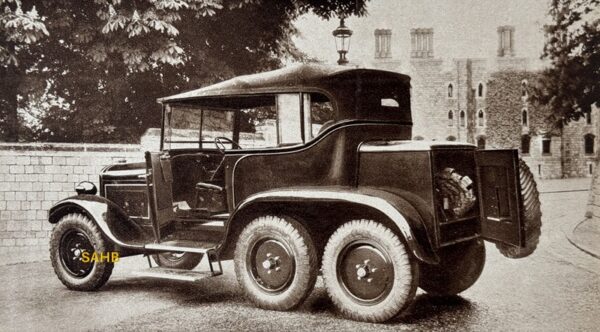
Much has been written about Crossley cars, but the company’s many commercial and military vehicles are perhaps less fully covered in general motoring history. The vehicle in this week’s Snapshot sits between these two aspects of Crossley’s output. It was built as a special order for King George V for use on the Sandringham estate. The Crossley chassis used is difficult to identify; contemporary reports merely state that the vehicle was rated at 19 h.p. (taxable).
The King had suffered ill health for some time, in particular following serious injury sustained in 1915 when he was thrown by his horse at a troop review in France. He also had chronic bronchitis. But the story of this Crossley is linked to an even more serious illness: in November 1928 he fell ill with septicaemia and for the next two years his son Edward (later to become Edward VIII and then the Duke of Windsor) took over many of his duties. Nevertheless, by September 1929 the newspapers were making optimistic noises about the King’s recovery, and the specialist motoring press reported that he wished to resume shooting expeditions; this special Crossley was designed to enable him to move around on rough ground in reasonable comfort.
A current website states that the body was by Barker, but a full report in 1929 identified the coachbuilder as Hooper (perhaps more likely, as a favoured coachbuilder for the Royal limousines). The six-wheeler was said to be “…essentially a go-anywhere vehicle. In it His Majesty will be able to travel in comfort over rough or broken ground, loose sand, or ploughed fields.” It was also claimed to be a practical road vehicle, having attained 60 mph during testing in Derbyshire. This was facilitated by a gearbox with normal and low ranges.
The open body with two rear seats was designed to accommodate the King and Queen and had several useful appointments, such as weather protection by Triplex glass screens to front and rear, an adjustable sloping footrest across the whole of the body and folding steps on the nearside that folded up automatically when the door was shut (visible in our Snapshot).
Our Snapshot also shows a curious heap of material sitting in the tool compartment at the rear of the vehicle. This was a set of special tracks that could be fitted to the rear wheels on very soft ground. Crossley was no stranger to this type of solution: it also manufactured several permanently tracked military vehicles for the British army and the RAF, using the Kégresse system under licence from Citroën.
The King’s vehicle may have been a one-off, but at the 1930 London Motor Show Crossley showed a prototype six-wheeled limousine with transmission and chassis based on the military/commercial vehicles. Production could have been intended, as the company produced a brochure, but almost certainly that production never took place. The fate of the King’s vehicle is not known.
Image courtesy of The Richard Roberts Archive: www.richardrobertsarchive.org.uk







Leave a Comment